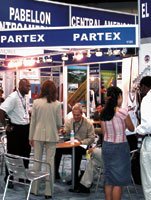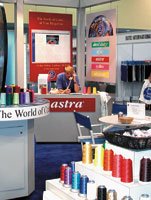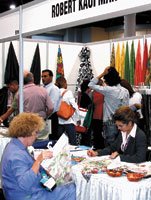Central, South American Trade, Sourcing Key at Material World Show
MIAMI BEACH, Fla.—Miami is at the crossroads of the Americas—a fact not lost on the organizers of 3-year-old sourcing and fabric trade show Material World.
The original idea behind Material World was to structure an exhibition that concentrated heavily on fabrics. But that goal has changed rather rapidly since the first show.
Almost one-third of the 350 exhibitors that signed up for this year’s show, held Sept. 29–Oct. 1 at the Miami Beach Convention Center, were contractors, textile companies or full-package factories from Latin America that are scrambling to take advantage of the hodgepodge of trade partnerships and free-trade agreements springing up between the United States, Latin America and other regions. Last year, there were 300 exhibitors. Attendance this year was up 12 percent.
“Material World began as a fabric show; there were fabric exhibitors at another show in the area that had other categories,” said Tim von Gal, executive vice president of marketing and development for Urban Expositions, the Marietta, Ga.–based organizer of Material World. “But they wanted a show that served this region, Miami and the Americas, where fabric was the centerpiece.”
But like the world trade situation, that focus suddenly changed to encompass more sourcing or locations to produce apparel. Material World this year was filled with back-to-back seminars on how to decipher the various trade agreements, whose acronyms sound more like ingredients for alphabet soup than trade pacts meant to lift developing nations out of poverty and provide a market for U.S.-made textiles.
Central American governments sent teams of business boosters to give talks on the advantages of doing business in the region.
At a seminar organized by the Nicaraguan government, many were astonished to hear that the average hourly wage for workers in that country is 67 cents, compared with $2.17 an hour in Mexico and 84 cents an hour in Guatemala. That makes the country, in terms of wages, cost competitive with China. The annual per capita income in Nicaragua is only $486.
With 65 percent of the country’s 5.1 million people under the age of 25, there is a large workforce that will need jobs in the not-so-distant future. Unemployment is at 13.5 percent. Underemployment totals 36.5 percent.
“People in the country really cherish their jobs and will do anything to keep them,” said Bernardo Callejas, the investment adviser at ProNicaragua, a businesspromotion agency formed by the government six months ago. “This is one of the last frontiers in the Americas.”
While labor is cheap, one American apparel factory owner, Joe Stephenson, who went to Nicaragua in 1993 to start two factories and now has eight plants, noted that those opening factories in the country will have to import middle managers because there are few Nicaraguans with the appropriate skills to fill those midlevel positions.
All of this jockeying for business is not just because of the Central American Free Trade Agreement that is expected to be hammered out by the end of this year and voted on by Congress next year. It is also because of the lifting of quotas on apparel and textiles in 2005 among World Trade Organization members, which will boost China as a major player in the apparel- manufacturing world.
Several Material World seminars discussed what Latin American manufacturers can expect after 2005. The message was succinct: They better improve every aspect of their businesses to survive.
Mark Neuman, a trade advisor for Limited Brands, noted that manufacturers and brands don’t necessarily run to the cheapest country to make their goods. A case in point is Hong Kong, where many manufacture clothing even though wages there are much higher than those in mainland China.
“On-time delivery of goods is a religion in Hong Kong and China,” Neuman said. “You see vendors who would rather lose money than not be on time.”
Latin American manufacturers have to incorporate a number of elements to remain competitive. Those include productdevelopment capabilities, efficiency, flexibility, high labor standards, a can-do attitude and quicker delivery of goods. “The biggest trend is speed,” Neuman explained.
Companies such as Limited, he said, want a higher inventory turnover ratio, a higher return on their assets and better merchandise for less money.
Mixed message
Outside the seminar rooms, the halls of the Miami Beach Convention Center were buzzing with activity on the first day of the show. Part of that activity was caused by the daylong drizzle that kept people inside. On the second day, when the sun emerged, things slowed a tad. Exhibitors, for the most part, were pleased by the overall turnout.
“For us, it is probably 60 to 70 percent better than the last Material World show in March,” said Brad Coombs, a sales representative for Robert Kaufman Fabrics Co. Inc., a textile converter based in Los Angeles.
On the first day of the show, sales representatives at the Robert Kaufman booth were mobbed as manufacturers expressed interest in retro-looking cotton fabrics with floral prints. The second day, things tapered off. “Manufacturers are definitely minding their Ps and Qs,” Coombs observed.
Rafael Ramirez, a market manager for Milliken & Co., a Spartanburg, S.C.–based company that has 68 knit and woven fabric plants in the United States and abroad, noted that things were slightly slower than they had been during the previous Material World trade show last March.
“We’ve been steady but not extremely busy,” Ramirez said. “But so far so good.”
About half of Ramirez’s customers were from the Miami region, 25 percent were from other parts of the United States and 25 percent came from Latin America.
Ricardo Sagrera, chairman and chief executive of Hilasal, a company that owns six apparel factories in El Salvador and two towel factories, said business was pretty good.
“Traffic is up,” Sagrera noted. “We’ve had four or five decent leads for the day.”
He is banking on improving his business with California clients, hoping to take advantage of the fact that El Salvador’s port is on the Pacific Ocean and fairly close to Los Angeles.
April Booth, the national sales manager for Eclat Textile Co. Ltd., based in City of Industry, Calif., said business was fairly good for her activewear and bodywear knit fabrics— much better than last March.
“We have some new customers, mostly from the East Coast,” Booth said. “And we’ve had some repeat business, also from the East Coast. This is our kind of show. It’s a knit show.”
One (Material) World
Organizers of Material World announced that their experiment with a semiannual trade show is over.
Next year, Material World will revert to being an annual show and will be bigger, combining technology, sewing equipment, textiles and sourcing. The show will be held May 18–20, 2004, at the Miami Beach Convention Center.
Sewn Products Equipment & Suppliers of the Americas, an expo that represents suppliers in the sewing industry, will be a part of next year’s trade show.
Material World started as an annual event when organizers launched it in September 2000. This year was the first year organizers held two Material World shows.
“The best improvement we can make is as an annual event,” said Tim von Gal, executive vice president of marketing and development for Urban Expositions, the Marietta, Ga.–based organizer of Material World. “We are going to expand our presence to include global sourcing more than we do now.”
























